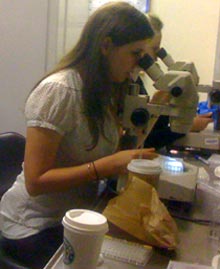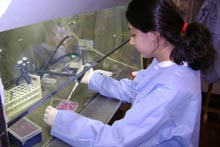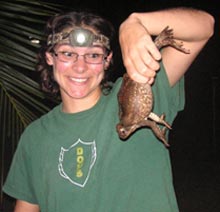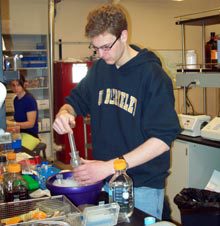Zachary Westrick
My experiment examines two possible models of how the brain determines which arm to use during reaching movements. Under the non-competitive model, the motor areas in each hemisphere formulate a plan and race until one has reached some threshold level of activation for movement, while the competitive model has the two hemispheres race while sending inhibitory signals to each other. I’ll be giving subjects a simple reaching task in which they must respond to cues on a screen, but occasionally withhold their movement in response to a later stop cue. […]
Eduardo Habitan Europa

My project investigates the nature of basic human economic principles with special focus on the scarcity bias – the tendency to select objects in greater scarcity. A recent study observed children were more likely to choose an object from the less abundant of two sets (Markson, personal communication). Before explaining this behavior, I am seeking factors that could confound this bias. I plan to test children and adults and see if visual information is required for exhibiting this behavior. Subjects will have the option of choosing an object after providing […]
Yannan Shen

Type II topoisomerases are enzymes that can change the topology of circular DNA molecules. These enzymes are essential to every living organism, which makes them good targets for anti-cancer and anti-bacterial drugs. DNA topology assays are used to determine the efficiency of topoisomerase inhibitors in drug design. In my research, I focus on the unknotting probability of knots by type II topoisomerases. In our previous study, our group built a mathematical model in simple cubic lattice to simulate how random strand passages generate the knotting distribution. We intended to use […]
Lauren Zerbib

The basis of sexual reproduction is a perennial topic of interest in evolutionary biology. The rotifer, Brachionus Calyciflorus, is an interesting system to compare sexual and asexual reproduction because it is cyclically parthenogenetic, meaning it alternates between generations produced sexually and asexually. By understanding the mechanisms controlling the timing of sexual reproduction in such organisms, we can better understand how natural selection determines the balance between asexual and sexual reproduction. In this study I look at the contributions of three related factors in determining the proportion of sexually reproducing daughters […]
Jane Yu
We are studying the role that a gene called KST245 plays in joint formation in mice. Currently, little is known about the regulation of joint development in the field of skeletal biology. However, through our research we hope to advance the field and share information that may be important in treating poorly understood joint diseases, such as arthritis. Mice that lack the functional KST245 gene (KST245 mutants) show irregular cartilage growth and misplaced joints. By examining the differences between the KST245 mutants and unaltered mice, we hope to understand the […]
Maansi Shah
DivL is an essential protein in Caulobacter crescentus that acts upstream of the master cell-cycle regulator, CtrA. Sequence analysis shows DivL to be homologous to histidine protein kinases, however, it has a tyrosine at its active site rather than a histidine. DivL is an essential protein but a mutant form of the protein, in which autophosphorylation is prevented by the substitution of phenylalanine for the tyrosine at the phosphorylation site, is still capable of supporting viability. Thus, DivL activates CtrA by a mechanism other than phosphorylation. The goal of my […]
Kamelia Ghazi

Curcumin (CUR), the active chemical of the Asian spice tumeric, has a strong anti-oxidant, anti-inflammatory effect in preventing neurodegenerative diseases like Alzheimers (AD), as well as an anti-proliferative effect on cancerous cells. Based on broad ranges of scientific literature on this topic, CUR has correlated with dramatic reduction in acetylation of histone. However, the precise mechanism by which curcumin achieves hypoacetylation and therefore represses the transcription of cancerous cells, is poorly understood. In this experiment, I will culture C6 rat glioma cells and through using immunostaining and protein assay, I […]
Sara Beth Weinstein

Chytridiomycosis has been implicated in the decline of many amphibian species. Most recent studies in this area have focused on the effects of the causative agent, Batrachochytrium dendrobatidis, on anurans. I have found evidence of this amphibian disease in a local salamander species, Batrachoseps attenuatus. This summer I intend to document the progression of this infection in a species that was previously assumed to be unaffected. This summers work is in preparation for subsequent research exploring the means of transmission of B. dendrobatidis, a fungus with an aquatic infectious stage, […]
Marina Nasrin Sharifi
I am characterizing a set of Chlamydomonas insertional mutants defective in carotenoid biosynthesis using pigment analysis, genetic crosses, and TAIL-PCR to connect mutations in specific genes with specific blocks in carotenoid biosynthesis,with the goal of elucidating in detail one or more steps in the Chlamydomonas carotenoid biosynthesis pathway. A better understanding of this is not only important for the understanding of the process of photosynthesis in general, but also in the comparison of carotenoid biosynthesis in the model organism Chlamydomonas with that in higher plants, possibly revealing interesting evolutionary and […]
Robert Bellerose

Biofuels have received much attention lately as the need for a renewable and carbon-neutral source of energy becomes increasingly important. We have assembled a biosynthetic pathway in Escherichia coli that produces butanol, a second generation biofuel, in six overall steps. However, there is a significant bottleneck at crotonyl-CoA reductase (Ccr) in the pathway that limits butanol production, which may be attributed to the observation that Ccr suffers from low solubility. The overall goal of my project is to carry out directed evolution of Ccr and generate a library of mutants […]